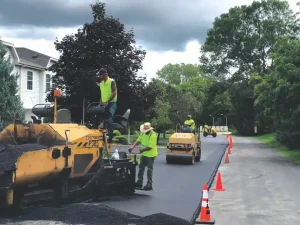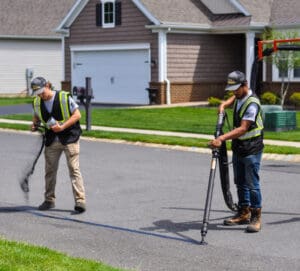The popularity of asphalt as a paving material across the United States is not by accident. Many Americans choose asphalt for their pavement applications because of its durability, resilience, and robustness. Sadly, like all other paved surfaces, asphalt pavement is not immune to damage and deterioration resulting from prolonged use and the laws of mother nature.
Asphalt pavements’ condition becomes less stellar over time, especially if not adequately maintained. Knowing the underlying causes of asphalt damage can be the key difference in sustaining the long-wearing properties of asphalt surfaces. The knowledge helps you adopt preventive measures or appropriate maintenance services to extend the integrity of that asphalt driveway, road, sidewalk, patio, playground, parking lot, or sports court.
Here are the three common reasons for asphalt damage
Leading Causes of Asphalt Damage
Traffic and Vehicle Load
Asphalt pavements are designed to withstand heavy loads, and it’s no wonder asphalt is preferred for highways and heavy-duty pavements. However, continued exposure to high traffic and heavy loads can cause pavement fatigue or progressive damage. The continued stress from substantial weight will cause the asphalt surface to bend and lose its form over time. Signs of extreme wear in particular areas of stress will begin to show.
You will notice pavement cracking, settling unevenly, breaking apart from high traffic, large commercial vehicles traveling across, or massive equipment parked on the surface. Moisture might penetrate the base, further fatiguing the asphalt and affecting all pavement layers. So, be mindful of the types of vehicles traveling across or parking on your asphalt pavement.
Extreme Weather Conditions
Asphalt pavements can experience damage from seasonal changes marked by heavy rains, harsh sun, and temperature changes. For instance, severe temperature drops during winter can cause significant material contraction leading to rigidity and cracks. The ground then thaws as snow and ice from winter melt during spring, causing an abundance of moisture that form puddles in the asphalt. During summer, asphalt will absorb solar radiation, and when coupled with intense temperatures, the surface will slough and develop cracks. The autumn season is known for its huge rain patterns. Flowing water from heavy rains can wear down the top layer of asphalt pavement while standing water seeps underneath and distorts the layers.
Oil, Gas, Chemicals, and other Toxin Substances
Gas, oil, and chemical leaks from vehicles can have detrimental effects on the quality of an asphalt surface. Many people make the mistake of assuming toxic substances do not have deteriorative effects on asphalt, so they do not clean after spillages and leaks. When these substances infiltrate the pavement, they can weaken the top layer and compromise the elasticity of the asphalt binder.
How Pro Pave Can Help
The deterioration of asphalt pavement is natural despite its toughness and ability to last longer. But, some pavements last longer than others, and the difference lies in the installation and maintenance of the pavements. Knowing the common causes of asphalt damage, it is crucial to take proper measures to maximize the longevity of your asphalt pavement. This involves partnering with the right contractor for your asphalt pavement installation and maintenance needs.
At Pro Pave Inc., we go the extra mile to help you avoid the problems above. Our professionals will install quality pavements less prone to adverse weather and can withstand heavy loads. We will also adopt advanced maintenance techniques to ensure your asphalt stays in prime condition for several years.
To learn more, write to us today or call us at (703) 433 9500.



